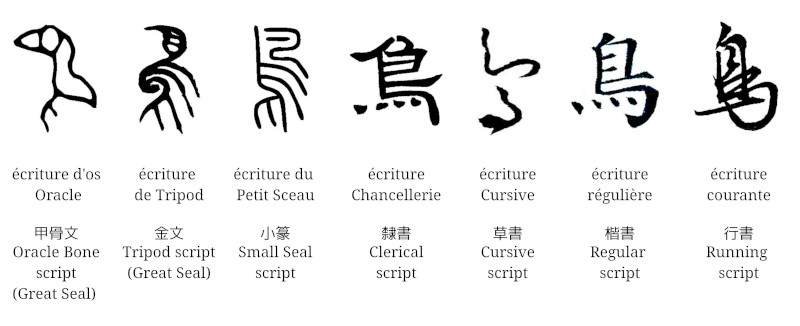Houston Community Colledge Art Group, Texas USA
Chinese Calligraphy Workshop
Le Centre St-Pierre, Montreal Quebec
Legendary Origins of Chinese Calligraphy
According to literary records, Chinese calligraphy may be traced to as far back as over three thousand years ago. However, tradition claims that Chinese characters were invented five thousands years ago.
In ancient classics, it was recorded as follows: “Ancient writings were invented by Ts’ang Chieh, the official chronicler of the Yellow Emperor. With four eyes and maintaining communion with the deities, Ts’ang Chieh looked up in the sky and noticed the round and curved shapes of the Constellations. He also stooped down to examine the patterns on the shell of a turtle and the traces left by birds. By extensively collecting the diverse beauties of the universe, he assimilated them into writing.
The story also adds, “When Ts’ang Chieh was composing characters, husked rice fell from the sky and the ghosts wept in the dark of the night.” To this marvelous story, explanations were offered as follows: The secrets of creations could hardly be hidden from humans anymore, therefore it rained husked rice. Because spirits and deities could no more conceal their shapes, the ghosts wept at night.
Evolution of Chinese calligraphy
Earliest chinese writing
Researchers identified more than 2,000 pictorial symbols dating back 8,000 years on cliff faces in the north-west of China. These symbols bear a strong resemblance to later forms of ancient Chinese characters. Chinese tradition claims that Chinese characters were invented five thousands years ago. “Four-eyes” Ts’ang Chieh, the official chronicler of the Yellow Emperor (2698–2598 BC), was a representative of the multitude. By observing many things in the universe, he uncovered the mysteries of the arts in nature. The ancient people then transformed their observations into idea images / pictograms, the very soul of Chinese calligraphy, which was revealed in the strokes. However Chinese Calligraphies are Not Pictures.
Unification of Chinese Writing ~ “Great Seal”
Prior to the Qin Empire, Chinese writings were not unified. Also the calligraphy script as a term was non-existent. In a broad sense, all kinds of writings previous to the Qin dynasty were named “Great Seal”. The writings on oracle bones and bell tripods of the Shang dynasty (1766 –1123 BC) were the earliest and the most important specimens of this script discovered so far.
Qin dynasty (221 BC–206 BC) ~ “Small Seal”
Under the reign of the Qin dynasty, for administrative convenience, all calligraphy scripts incompatible with that of the former Qin State were abolished and fell into desuetude. The unified writing of the dynasty was named “Small Seal”.
Han dynasty (206 BC – 220 AD)
The calligraphy successively underwent evolutionary changes from Seal into clerical, Cursive, Running and Regular scripts. During this dynasty, basically all calligraphy scripts had reached their appropriate levels of distinction.
Tang dynasty (618 to 907)
Regular script of Tang dynasty was well known for restricted modes to a norm and standard. However the Cursive script developped to a wild, frantic and liberal manner. Thereby it encroached upon the stratum of pure art, quite detached from the level of practical value.
Song Dynasty (960 – 1279)
Song calligraphers always tried to free themselves from the restricted modes of the Tang calligraphic styles and ventured beyond to create individual styles, as “romantic and liberated”.
Yuan dynasty (1271 – 1368)
Revival of Ancient Styles of classical Jin dynasty (266–420) and Tang dynasty calligraphic styles.
Ming Dynasty (1368 - 1644)
Those who practiced and commented about the art mostly plagiarized and imitated masters from previous dynasties, so original creation was not really noticeable. On the other hand, the transmission and engraving of stelae was very active and the study of calligraphy manuscript was also very popular.
Qing Dynasty (1644 – 1911)
Chinese calligraphy experienced a difficult transformation; the calligraphy styles from the Song, Yuan and Ming Dynasties (mainly from manuscripts) became a bit neglected. During this dynasty, the study of styles found in stelae, especially Seal, Clerical and Regular scripts were favored.
Nowadays
The traditional calligraphy is considered as a National culture treasure. It is an abstract visual art which is detached from the level of practical value.
The main scripts of Chinese calligraphy ~ Character [鳥] bird as an example
As Chinese writings have undergone complex evolutionary stages, it is difficult to specify the date when each calligraphy script emerged. Moreover, it is equally difficult to clearly demarcate and define all the transitional styles of calligraphy script.

Useful links
Chinese Calligraphy
- World History Encyclopedia: Ancient Chinese Calligraphy
- Chine365: Comprendre la calligraphie chinoise
- Unesco: intangible cultural heritage
"Calligraphy established itself as the most important ancient Chinese art form alongside painting, first coming to the fore during the Han dynasty (206 BCE - 220 CE). All educated men and some court women were expected to be proficient at it, an expectation which remained well into modern times. Far more than mere writing, good calligraphy exhibited an exquisite brush control and attention to composition, but the actual manner of writing was also important with rapid, spontaneous strokes being the ideal. The brushwork of calligraphy, its philosophy, and materials would influence Chinese painting styles, especially landscape painting, and many of the ancient scripts are still imitated today in modern Chinese writing."
"La beauté de la calligraphie chinoise est indéniable et d'une grande portée, mais les courbes, les lignes et les traits ensorcelants sur le papier vont au-delà de la simple esthétique. L'acte même d'écrire en Chine est une forme d'art ; une danse expressive du pinceau et de l'encre, imprégnée de milliers d'années d'histoire et de tradition. Bienvenue dans le monde fascinant de la calligraphie chinoise !"
"Inscribed in 2009 (4.COM) on the Representative List of the Intangible Cultural Heritage of Humanity"
Languages in China
Ngan Siu-Mui's calligraphy book
Contents: Ngan Siu-Mui
Webmaster: jy-pelletier
Tous droits réservés — All rights reserved — 版 權 所 有
顏 小 梅 (Ngan Siu-Mui) — 2004
 top of page
top of page